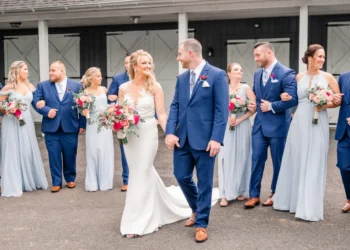Introduction
A wedding is a once-in-a-lifetime event, and capturing its magic through a photoshoot is an art that demands both creativity and technical skill. In this comprehensive guide, we delve into the essential tips that will help you create a stunning wedding photoshoot, one that not only documents the day but also tells a story of love, emotion, and timeless memories.
Understanding the Couple’s Vision
Every couple has a unique vision for their wedding photos, and as photographers, it is crucial to understand and align with that vision. Communication is key; take the time to discuss with the couple their preferences, styles, and specific moments they want to capture. Whether they prefer candid shots, traditional poses, or a mix of both, understanding their expectations will lay the foundation for a successful shoot.
Key Points to Discuss with the Couple:
- Preferred Style: Candid, posed, or a combination
- Important Moments: First look, exchange of vows, first dance
- Venue Considerations: Indoor, outdoor, lighting conditions
- Special Requests: Family portraits, specific groupings, or unique locations

Choosing the Perfect Location
The location of the photoshoot plays a significant role in the overall aesthetic of the wedding album. Whether the couple has chosen a scenic outdoor venue or a grand indoor setting, each location comes with its own set of challenges and opportunities. Scout the venue ahead of time to identify the best spots for photos, considering factors such as lighting, background, and accessibility.
Location Scouting Tips:
- Visit at the Same Time of Day: Understand how the lighting will affect your shots.
- Identify Key Backdrops: Look for natural frames, interesting textures, and scenic views.
- Consider the Weather: Have a plan for both sunny and cloudy conditions.
- Accessibility: Ensure that all locations are easily accessible, especially for group shots.
Mastering the Art of Lighting
Lighting is the cornerstone of photography, and mastering it is crucial for a successful wedding photoshoot. Whether you are working with natural light or using artificial lighting setups, understanding how to manipulate light will dramatically improve the quality of your photos.
Natural Light Techniques:
- Golden Hour: The soft, warm light during sunrise or sunset is ideal for romantic shots.
- Diffused Light: Overcast days offer even, diffused light that reduces harsh shadows.
- Backlighting: Create a halo effect by positioning the couple with the sun behind them.
Artificial Lighting Tips:
- Off-Camera Flash: Use to fill in shadows and add depth to indoor shots.
- Reflectors: Bounce light to highlight the couple’s features and add dimension.
- Continuous Lighting: Useful for consistent exposure during indoor ceremonies.

Posing and Composition
A well-composed photograph captures the essence of a moment, and posing is an essential element in achieving this. While candid shots have their charm, posed photos can highlight the couple’s connection and the beauty of their surroundings.
Effective Posing Techniques:
- Natural Interactions: Encourage the couple to interact naturally, whether it’s a shared laugh or a tender glance.
- Guiding Hands and Feet: Small adjustments in hand and foot placement can make a big difference in the overall composition.
- Utilizing Angles: Shoot from different angles to find the most flattering perspective for the couple.
Composition Guidelines:
- Rule of Thirds: Position the couple off-center to create a more dynamic image.
- Leading Lines: Use natural lines in the environment to draw attention to the couple.
- Symmetry and Balance: Frame shots to create a sense of harmony and balance.
Capturing Candid Moments
While posed photos are essential, candid shots often capture the most genuine emotions. Being unobtrusive and ready to shoot at a moment’s notice will allow you to document the spontaneous moments that make the day unforgettable.
Tips for Capturing Candid Shots:
- Stay Alert: Always be on the lookout for emotional moments, such as a tearful exchange or a joyful laugh.
- Use a Long Lens: This allows you to capture intimate moments without being intrusive.
- Blend In: Dress appropriately and move discreetly to avoid drawing attention to yourself.

Editing and Post-Processing
The work doesn’t end when the wedding is over. Post-processing is where you can enhance the beauty of the photos and bring the couple’s vision to life. From color correction to retouching, every detail matters in creating a polished final product.
Essential Editing Techniques:
- Color Correction: Adjust white balance and color tones to achieve a consistent look across all photos.
- Retouching: Remove blemishes, smooth skin, and enhance details to make the couple look their best.
- Cropping and Framing: Refine the composition by cropping to highlight the most important elements.
- Consistency: Ensure a cohesive style throughout the album by applying similar edits to all images.
Delivering the Final Product
Presentation is just as important as the photos themselves. How you deliver the final product will leave a lasting impression on the couple. Whether you opt for a digital gallery, a printed album, or a combination of both, ensure that the quality of the presentation matches the quality of the photos.
Presentation Tips:
- High-Resolution Images: Deliver images in both web-ready and print-ready formats.
- Online Gallery: Provide a user-friendly platform where the couple can view and share their photos.
- Custom Albums: Offer a range of album styles that can be personalized to the couple’s taste.
- Timely Delivery: Set realistic deadlines and communicate clearly with the couple to manage expectations.
Conclusion
A wedding photoshoot is more than just capturing images; it’s about telling a love story that will be cherished for generations. By understanding the couple’s vision, mastering lighting and composition, and delivering a polished final product, you can create a wedding album that stands out and resonates with the couple on an emotional level.





